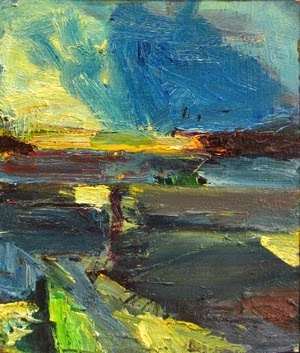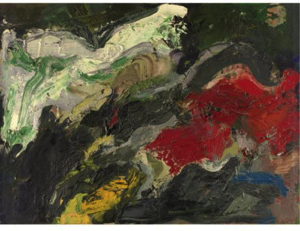| •Terry St. John: New and Recent Paintings and Drawings. Dolby Chadwick Gallery, 210 Post Street, San Francisco Exhibition continues through August 30 |
 |
| Terry St. John: Thai Woman with Cup (2012), oil/canvas, 48x42 inches |
St. John was born in Sacramento in 1934 but grew up in Berkeley — he was a schoolmate of mine at Garfield Junior High School in the late 1940s, though we weren't friends at the time. He came to painting only in his last year of college, when on seeing work a friend was doing, studying at the time with Richard Diebenkorn, he was struck by the clarity and presence of purpose the discipline offered. Frances Malcolm quotes him in her introductory essay in the catalogue to the current exhibition:
…above all else, I just wanted to paint paintings. Painting somehow gave me an opening to the future and a sense of hope… it was salutary.
St. John worked among other painters in his early days. He was a great friend of Lou Siegreist, the youngest and last surviving of the legendary Society of Six early modern Bay Area painters, and of his son Lundy; the three often painted en plein air in the local landscape, particularly the slopes of Mount Diablo. St. John worked for years at a day job, curating modern painting at the Oakland Museum. He taught, too, at Notre Dame de Namur University in Belmont.
In spite of his sociability, though, he has always impressed me as a kind of solitary — a man who knows and keeps his own place and counsel. You have the impression it is the solitary discipline of painting that holds and informs him, that defines his address to life and to context. Whether working in the landscape or in the studio, it's the sense of the passage of time, as Malcolm suggests, that energizes his work, leaves traces of light and shadow, develops the evolving colors, finds the balance of recessive depth, spatial organization, visual meaning.
I have loved his work for years, and am pleased to have a small landscape. But I was unprepared for the new and recent work now on view. I had lost touch with both him and his work in the last ten years. His painting has developed great strength, depth, complexity, and certainty. As can happen this late in life, he has found a great sense of assurance — these paintings are vibrant and full of energy, God knows; but they are serene, objective, composed, competent.
I like the way so much painting history, internationally and locally, is contained, even referred to, with knowledge and intelligence, on completely equal terms, without his work ever seeming the slightest bit derivative. Thai Woman with Cup, for example, is fully aware of Cubism; it makes me think of the CoBrA school too; its window recalls the Matisse behind Diebenkorn; the seated nude brings Elmer Bischoff to mind: but the complexity of the left third of the painting oddly balancing the cool window on the right is something new to me — and the red shoe!
The newest canvases here, from 2013. are exclusively paintings of the nude, mostly in interiors though occasionally ambiguously so, perhaps in tropical landscapes — for a number of years St. John was spending part of each year in Thailand. There are a few smaller landscapes, though, from not that long ago, showing the artist is loyal to the Bay Area, and that its views continue to ground the solidity and geometry of his vision, as well as the texture, color, and light.
 Wine Haven (Pt. Molate) (2008) |  Diablo (2010) |  Woman with Green Bottle (2014) |
|---|
I was asked, in the gallery, which painting I'd take home with me, if I could. (I couldn't afford any of them, of course; and in any case every one of them seems already to have been sold.) Woman with Green Bottle, I said. The strength and solidity of the others is here, but I like the comparative simplicity, the domesticity, the classical subtlety of its geometrical relationships, the relationship of bottle, drapery, and the painting on the wall. I like the sense of history. And most of all, I think, I like the humor pervading the entire vision. St. John seems to have arrived at a sense of unusually sure and engaged and bemused awareness of existence, and I'm glad for the opportunity he gives of sharing it.
Bay Area Expressionism
I leave him, and you, dear reader, with a quick survey of some of the painters I've mentioned above, to provide some context for this sumptuous show of a painter arrived at mastery:
 Lou Siegriest |  Jack Jefferson |  Julius Hatofsky |  Julius Wasserstein |
|---|
2 comments:
I'm delighted to have been introduced to more powerful Bay Area Expressionist painters, the "J's", as you call them.
I'd add two more to this growing group of under-represented painters from this school: Harold Frank and Henry Villierme.
Why do believe that the Bay Area School has gotten such little exposure, compared to East Coast artists doing similar work? Is it really just that so much of art criticism came from the East in the mid-20th century?
There's so much to be said about your last paragraph. There are two kinds of provincial cultures, I think: those that think they are the center of the universe, and those who feel marginal to the self-appointed centers. The first Bay Area art culture I knew was that of the 1950s and early 1960s, which was composed of men and women who knew global things but who worked in an area still relatively isolated. Television and jet travel changed that. The Bay Area went from a community comfortable with its own identity to one self-consciously uncertain about it. What Oakland used to be to San Francisco, the Bay Area became to New York. Critics and curators began to be imported from back east. Regionalism has become a dirty word, but Sense of Place is honorable. Alas, it fell out of fashion. I cherish and honor the artists who continue to observe it, rejecting Koonishness, continuing to expand organically on their own place and history.
I didn't know about Harold Frank, whose Wikipedia entry suggests he was a New York painter who later moved to Southern California. Nor am I familiar with Henry Villierme's work. After a childhood in Tahiti he spent his teens in the Bay Area, apparently, and studied under Diebenkorn at California College of Arts and Crafts before resettling to Southern California.
Post a Comment